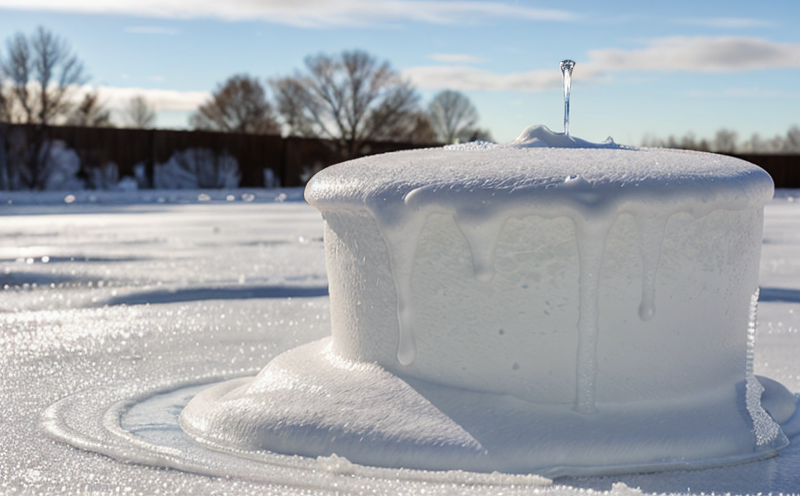MIL-STD-810 Method 506 Rain Impact Simulation Testing
The MIL-STD-810 Method 506 Rain Impact Simulation Test is a critical procedure used to evaluate the durability and reliability of materials, components, and systems under simulated rain conditions. This testing method is particularly important for products that operate in harsh environmental conditions such as aerospace and aviation applications where exposure to weather elements like rain can significantly affect performance.
The objective of this test is to simulate the impact of rain on various materials and assemblies to assess their resistance to water infiltration, erosion, and overall integrity. The standard provides a robust framework for testing under controlled laboratory conditions that mimic real-world environments. This ensures that products meet stringent military specifications and can perform reliably in operational scenarios.
The test involves subjecting specimens to a specified volume of rain over a defined period at a specific temperature and humidity level. Specimens are subjected to drops ranging from 2mm to 10mm in diameter, with impact speeds typically between 5 m/s and 10 m/s. The duration of the test can vary based on the material properties and the desired outcome.
The test setup includes a rain simulator that delivers water droplets onto the specimen surface. This apparatus is designed to replicate natural rainfall conditions accurately. The intensity, frequency, and duration of the rain exposure are meticulously controlled to ensure consistency with the specified MIL-STD-810 criteria. Post-test inspections involve visual examination, dimensional measurements, and non-destructive testing (NDT) methods such as ultrasonic or radiographic inspection.
The test results provide valuable insights into the material's ability to withstand environmental stressors. This information is crucial for quality assurance and compliance with international standards like ISO 12944, which addresses corrosion protection of iron and steel in marine environments. The data collected during these tests helps manufacturers make informed decisions about design modifications or component replacements.
By adhering to MIL-STD-810 Method 506, organizations can ensure that their products meet stringent reliability requirements and are capable of withstanding the rigors of real-world conditions. This is particularly important for aerospace and aviation industries where product performance directly impacts safety and operational efficiency.
International Acceptance and Recognition
MIL-STD-810 Method 506 Rain Impact Simulation Testing has gained widespread acceptance across various sectors, including aerospace, defense, and transportation. Its rigorous standards have been recognized by international bodies such as the International Organization for Standardization (ISO) and the European Committee for Standardization (CEN). Compliance with this standard is often a prerequisite for export to countries that adhere to NATO or U.S. military specifications.
The method's acceptance extends beyond mere compliance; it also fosters innovation by providing a benchmark against which new materials and technologies can be evaluated. This ensures that products not only meet current standards but are also prepared for future challenges in harsh environmental conditions.
Organizations that adopt MIL-STD-810 Method 506 Rain Impact Simulation Testing benefit from enhanced credibility within the industry, as it demonstrates a commitment to quality and reliability. Certification under this standard can lead to increased market share by ensuring that products are robust enough for global deployment.
Competitive Advantage and Market Impact
- Innovation Leadership: Compliance with MIL-STD-810 Method 506 Rain Impact Simulation Testing allows companies to stay ahead of the curve in terms of product development. By adhering to this stringent standard, organizations can introduce products that are not only reliable but also environmentally resilient.
- Better Customer Satisfaction: Products tested according to MIL-STD-810 Method 506 Rain Impact Simulation Testing tend to have higher durability and longevity, leading to increased customer satisfaction. This can translate into repeat business and positive word-of-mouth recommendations.
- Increased Market Share: The global aerospace and defense industries are highly competitive. By ensuring that products meet or exceed MIL-STD-810 specifications, companies can differentiate themselves from competitors and capture a larger share of the market.
The ability to demonstrate compliance with MIL-STD-810 Method 506 Rain Impact Simulation Testing provides a significant advantage in bidding for contracts. Many government agencies and private organizations specify this standard as a requirement for procurement, making it an essential tool for business growth.
Use Cases and Application Examples
| Application Area | Test Parameters | Expected Outcome |
|---|---|---|
| Aircraft Structures | Durability of composite materials under rain impact | Evaluation of structural integrity and resistance to water infiltration |
| Military Electronics | Waterproofing effectiveness of enclosures and connectors | Assessment of electrical performance in wet environments |
| Aerospace Propulsion Systems | Impact on engine components during rain exposure | Determination of corrosion resistance and operational reliability |
The MIL-STD-810 Method 506 Rain Impact Simulation Testing is applicable to a wide range of aerospace and aviation products. For instance, in the case of aircraft structures, it helps evaluate the durability of composite materials under rain impact conditions. This ensures that these materials can withstand prolonged exposure without compromising structural integrity.
In military electronics applications, the test assesses the waterproofing effectiveness of enclosures and connectors to ensure they maintain their electrical performance even in wet environments. This is crucial for maintaining operational reliability during field operations.
For aerospace propulsion systems, the test evaluates how engine components are impacted by rain exposure. This helps determine the corrosion resistance and overall operational reliability of these critical components. Ensuring that engines can perform reliably under such conditions enhances safety and mission success.





